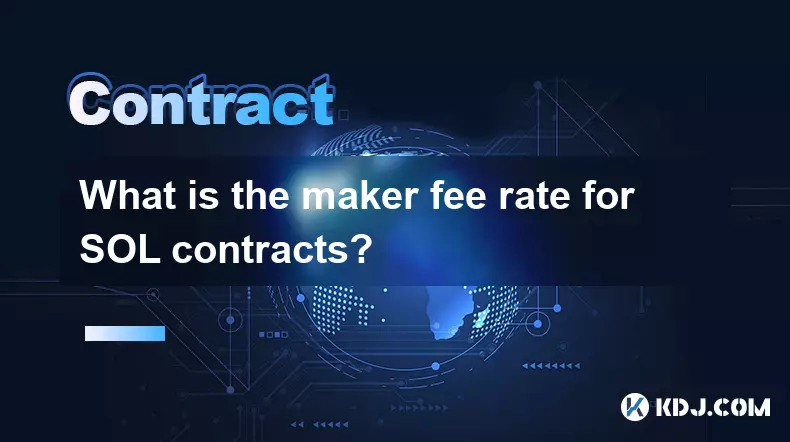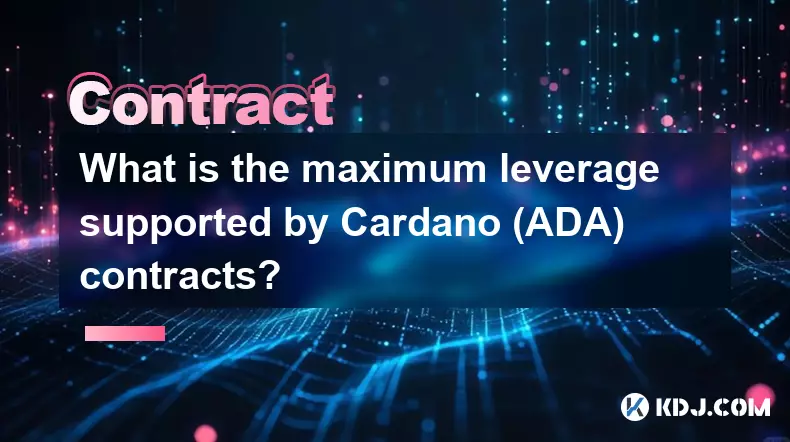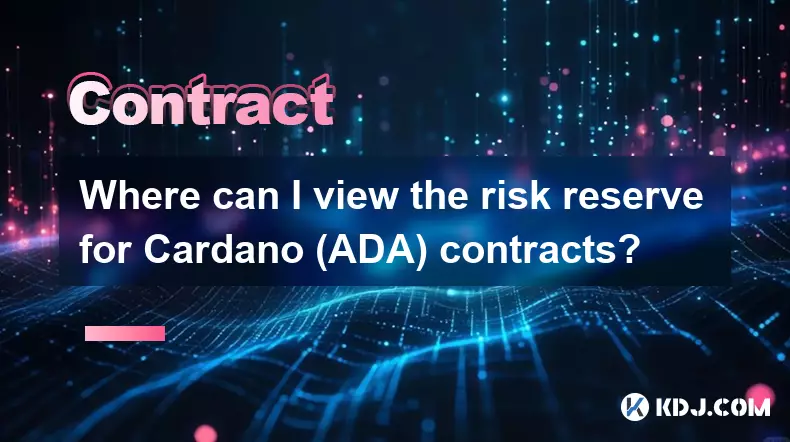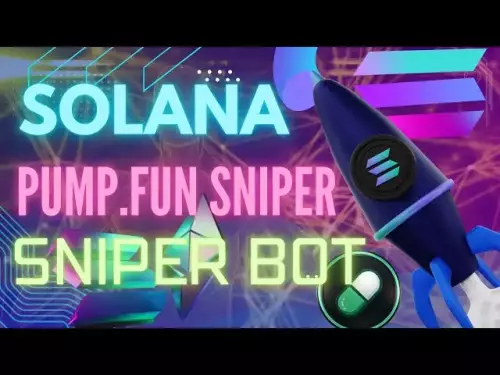-
 bitcoin
bitcoin $112195.049338 USD
2.42% -
 ethereum
ethereum $4124.915858 USD
2.81% -
 tether
tether $1.000570 USD
0.02% -
 xrp
xrp $2.861568 USD
2.25% -
 bnb
bnb $1000.346670 USD
3.04% -
 solana
solana $209.070819 USD
3.38% -
 usd-coin
usd-coin $0.999870 USD
0.02% -
 dogecoin
dogecoin $0.235379 USD
2.65% -
 tron
tron $0.335681 USD
-0.20% -
 cardano
cardano $0.803501 USD
3.38% -
 hyperliquid
hyperliquid $47.120881 USD
3.56% -
 chainlink
chainlink $21.501300 USD
3.44% -
 ethena-usde
ethena-usde $1.000571 USD
0.02% -
 avalanche
avalanche $29.793378 USD
3.62% -
 stellar
stellar $0.366964 USD
2.42%
What is the maker fee rate for SOL contracts?
Maker fees for SOL contracts on Solana typically range from 0.01% to 0.02%, with some platforms offering rebates or dynamic rates to incentivize liquidity provision.
Sep 28, 2025 at 03:55 pm

Understanding Maker Fees in SOL Contracts
1. The maker fee rate for SOL contracts on most decentralized exchanges and derivatives platforms typically ranges between 0.01% and 0.02%. This fee is charged to traders who place limit orders that add liquidity to the order book. Since these orders do not execute immediately but wait to be matched, they are considered 'makers' of market depth.
2. Platforms such as Mango Markets and Drift Protocol have implemented competitive maker fee structures to attract high-frequency traders and market makers. On Drift, for example, the standard maker fee is set at 0.01%, making it cost-effective for users to provide liquidity without significantly eroding their profit margins.
3. Some exchanges offer negative maker fees under certain conditions, effectively rewarding users for placing limit orders. In such cases, instead of paying a fee, the maker receives a small rebate. This model is less common in the Solana ecosystem but has been tested during promotional liquidity mining events.
4. It's important to differentiate maker fees from taker fees, which are generally higher. While maker fees incentivize order placement, taker fees apply to market orders that remove liquidity. For SOL perpetual contracts, taker fees often range from 0.04% to 0.06%, creating a spread that benefits the exchange and encourages balanced trading behavior.
5. Fee rates can vary based on user tier levels, determined by trading volume or staked tokens. High-volume traders may qualify for reduced or even zero maker fees, enhancing their ability to deploy algorithmic strategies on Solana-based derivatives platforms.
Liquidity Incentives and Platform Design
1. Solana’s low transaction costs and high throughput make it ideal for high-frequency trading, where small differences in maker fees can significantly impact profitability. Platforms built on Solana leverage this advantage by offering tighter spreads and lower fees to attract global liquidity providers.
2. Many protocols implement dynamic fee models where maker rates adjust according to market conditions, volatility, or imbalance in buy/sell orders. These adaptive systems help maintain healthy order books, especially during periods of rapid price movement in SOL.
3. Liquidity mining programs often supplement low maker fees with additional token rewards. Users who consistently act as makers may earn governance tokens or platform-specific incentives, further reducing their effective trading costs.
4. Order book design plays a crucial role in how maker fees are perceived. Central limit order books (CLOBs) on Solana, like those used by Zeta Markets, prioritize transparency and fairness, ensuring that maker fee structures align with long-term ecosystem growth rather than short-term revenue extraction.
5. Open-source order matching engines allow third-party developers to audit and verify fee calculations. This transparency builds trust among professional traders who rely on precise execution economics when engaging with SOL futures and options contracts.
Impact of Network Congestion on Trading Costs
1. Although base maker fees remain stable, network congestion on Solana can indirectly affect trading costs. During peak activity, priority fees (tips to validators) may rise, increasing the total cost of submitting limit orders even if the protocol fee stays unchanged.
2. Some trading platforms absorb network-level fees to maintain consistent user experience, especially for institutional clients. This practice ensures that the advertised maker fee reflects the actual cost borne by the trader, regardless of mempool congestion.
3. Compression techniques and layer-2 style solutions like noop transactions help minimize on-chain load, keeping transaction costs near zero. As a result, the economic burden of being a maker remains minimal compared to other blockchain networks.
4. Real-time monitoring tools allow traders to assess both protocol fees and estimated execution costs before placing orders. Dashboards integrated with Solana’s RPC endpoints provide granular insights into historical fee trends and current network conditions.
5. Despite temporary fluctuations in validator tips, the core maker fee rate for SOL contracts remains predictable and among the lowest in the cryptocurrency derivatives space.
Frequently Asked Questions
What determines whether a trade qualifies as a maker? A trade is classified as a maker when the order does not execute immediately and instead rests on the order book, contributing to market depth. Limit orders that add liquidity fall into this category, while market orders or limit orders that match existing ones are considered takers.
Do all Solana-based exchanges charge the same maker fee? No, maker fees differ across platforms. While many hover around 0.01%, some exchanges adjust rates based on product type, user tier, or promotional campaigns. Traders should review each platform’s fee schedule before deploying capital.
Can maker fees change without notice? Most reputable platforms announce fee changes through governance proposals or official communications. However, dynamic fee mechanisms may automatically adjust rates within predefined parameters based on market data, without requiring manual intervention.
Are there hidden costs beyond the stated maker fee? The primary cost is the protocol fee, but users must also account for Solana transaction fees, which are usually negligible. Wallet signing operations and failed transactions due to slippage or timing issues may incur additional costs unrelated to the maker/taker model.
Disclaimer:info@kdj.com
The information provided is not trading advice. kdj.com does not assume any responsibility for any investments made based on the information provided in this article. Cryptocurrencies are highly volatile and it is highly recommended that you invest with caution after thorough research!
If you believe that the content used on this website infringes your copyright, please contact us immediately (info@kdj.com) and we will delete it promptly.
- SWIFT, Consensys, and Blockchain Settlement: A New Era for Global Finance?
- 2025-09-30 06:25:13
- Gold Dollar Coin, Mystery, Upright 5: Unearthing Hidden History and Whale-Sized Speculation
- 2025-09-30 06:25:13
- Meme Coins, Smart Money, 2025 Riches: Navigating the Hype
- 2025-09-30 06:30:01
- VeChain (VET) Price Prediction 2026: Bullish Breakout or Enterprise Stalemate?
- 2025-09-30 06:30:01
- BetFi Coin: Is This the Next High-ROI Crypto Presale?
- 2025-09-30 06:30:01
- Bitcoin, Nvidia, and the Potential Upside: Lessons from the AI Boom
- 2025-09-30 06:30:15
Related knowledge

What is the maximum leverage supported by Cardano (ADA) contracts?
Sep 30,2025 at 03:37am
Understanding Leverage in ADA Derivatives Trading1. Leverage in cryptocurrency futures and perpetual contracts allows traders to control larger positi...

How do I use the scheduled order feature in Cardano (ADA) contracts?
Sep 28,2025 at 10:18pm
Understanding Scheduled Orders in Cardano Smart ContractsCardano operates on a proof-of-stakes consensus mechanism and uses the Plutus scripting langu...

Where can I view the risk reserve for Cardano (ADA) contracts?
Sep 29,2025 at 09:19pm
Risk Reserve Overview in Cardano (ADA) Ecosystem1. The concept of a risk reserve within the Cardano blockchain does not align with traditional central...

How do I enable the "scalping-only" mode for Cardano (ADA) contracts?
Sep 24,2025 at 03:19am
Understanding Scalping Strategies in Crypto Derivatives1. Scalping in cryptocurrency trading refers to executing multiple short-term trades within min...

What is the settlement time for Cardano (ADA) contracts?
Sep 28,2025 at 04:18am
Understanding Cardano's Contract Settlement Mechanism1. Cardano operates on a proof-of-stake consensus model known as Ouroboros, which fundamentally i...

How do I add margin to Cardano (ADA) contracts?
Sep 27,2025 at 07:54pm
Understanding Margin in Cardano (ADA) Smart ContractsCardano operates on a proof-of-stake blockchain that supports smart contracts through its Plutus ...

What is the maximum leverage supported by Cardano (ADA) contracts?
Sep 30,2025 at 03:37am
Understanding Leverage in ADA Derivatives Trading1. Leverage in cryptocurrency futures and perpetual contracts allows traders to control larger positi...

How do I use the scheduled order feature in Cardano (ADA) contracts?
Sep 28,2025 at 10:18pm
Understanding Scheduled Orders in Cardano Smart ContractsCardano operates on a proof-of-stakes consensus mechanism and uses the Plutus scripting langu...

Where can I view the risk reserve for Cardano (ADA) contracts?
Sep 29,2025 at 09:19pm
Risk Reserve Overview in Cardano (ADA) Ecosystem1. The concept of a risk reserve within the Cardano blockchain does not align with traditional central...

How do I enable the "scalping-only" mode for Cardano (ADA) contracts?
Sep 24,2025 at 03:19am
Understanding Scalping Strategies in Crypto Derivatives1. Scalping in cryptocurrency trading refers to executing multiple short-term trades within min...

What is the settlement time for Cardano (ADA) contracts?
Sep 28,2025 at 04:18am
Understanding Cardano's Contract Settlement Mechanism1. Cardano operates on a proof-of-stake consensus model known as Ouroboros, which fundamentally i...

How do I add margin to Cardano (ADA) contracts?
Sep 27,2025 at 07:54pm
Understanding Margin in Cardano (ADA) Smart ContractsCardano operates on a proof-of-stake blockchain that supports smart contracts through its Plutus ...
See all articles


























![[Pycoin] PI Coin -Shocking Listance of Pycoin?! 'Rebellion' This time ... Pay attention to #paikoin [Pycoin] PI Coin -Shocking Listance of Pycoin?! 'Rebellion' This time ... Pay attention to #paikoin](/uploads/2025/09/29/cryptocurrencies-news/videos/pycoin-pi-coin-shocking-listance-pycoin-rebellion-time-pay-attention-paikoin/68da82f23cec1_image_500_375.webp)















































